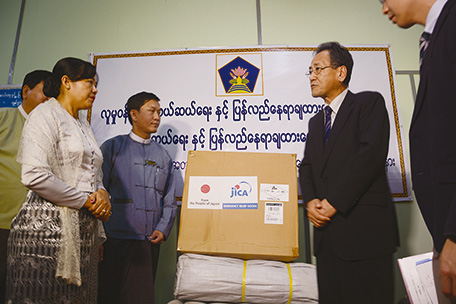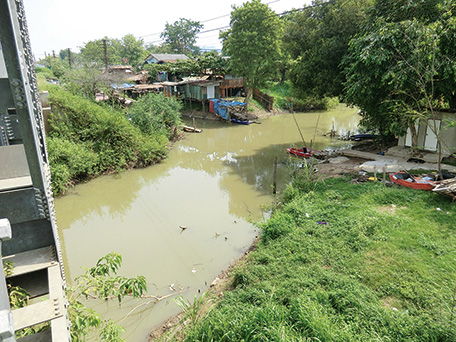(2) Emergency Humanitarian Assistance after Natural Disasters
Japan stands ready for immediate provision of emergency assistance in response to requests from the government of an affected country or an international organization when large-scale disasters occur overseas. Japan has four types of Japan Disaster Relief (JDR) Teams to provide humanitarian assistance: (i) Search and Rescue Team to search for and rescue affected people; (ii) Medical Team to provide emergency medical assistance; (iii) Expert Team to give technical advice or guidance on emergency response measures and recovery operations; and (iv) Self-Defense Force Unit to undertake medical activities, transportation of aid supplies and personnel when it is deemed particularly necessary in response to large-scale disasters. In addition, under the Basic Design for Peace and Health, the Infectious Diseases Response Team has been newly established and is now striving to provide assistance more effectively.
In-kind assistance includes the provision of Emergency Relief Goods. Japan stockpiles tents, blankets, and other goods needed by those affected by disasters in the immediate disaster aftermath, at overseas warehouses in four locations, which enables Japan to be prepared to quickly provide relief goods to affected countries when disasters occur. In FY2014, Japan provided emergency relief goods for a total of 23 incidents in 19 countries, including the Philippines, Paraguay, and Mozambique.
Moreover, with the aim to provide relief to displaced persons or people affected by natural disasters and/or conflicts, Japan extends Emergency Grant Aid to the governments of affected countries as well as international organizations that provide emergency assistance in areas affected by the disasters. In many cases Japanese NGOs work as partners when these international organizations provide actual emergency assistance. In FY2014, Emergency Grant Aid was extended through international organizations and other institutions mainly for humanitarian assistance to those affected by natural disasters in India, Pakistan and other parts of Asia.
Additionally, Japanese NGOs provide various forms of assistance to those affected by disasters, whom government aid does not always reach, by utilizing ODA funds to meet their needs. Japan Platform (JPF), an international emergency humanitarian aid organization established through the partnership and cooperation of NGOs, business communities and the Government of Japan, dispatches member NGOs to provide assistance to refugees, IDPs, or people affected by conflict or natural disasters.
In FY2014, JPF provided humanitarian assistance for those affected by the floods in Northern Afghanistan and the floods in Southeast Asia. JPF also set up a humanitarian assistance program following the April 2015 earthquake in Nepal in which JPF member NGOs provided assistance tailored to local needs mainly in mountainous areas where damages were extensive. Asia Pacific Alliance for Disaster Management, a disaster risk reduction cooperation network founded in Japan with extensive linkages with emergency humanitarian assistance NGOs and private sector organizations in five Asian countries, also utilized funds from the Government of Japan to conduct search and rescue activities as well as provide medical assistance and distribute food and other relief goods.
Based on its traditional friendly relationship with Nepal and in response to the request of the Government of Nepal, Japan provided emergency relief goods (tents and blankets, etc.) and emergency grant aid of $14 million (approximately ¥1.68 billion) for the magnitude 7.8 earthquake that struck central and western Nepal in April 2015. Japan also dispatched the JDR Team (comprised of Search and Rescue and Medical teams as well as JSDF units) to provide emergency humanitarian assistance to those affected. The JDR Teams operated around four weeks in Nepal where they provided assistance in the capital of Kathmandu and its suburbs, as well as in Sindhupalchowk District where damages were most extensive.
In addition, Japan dispatched the JDR Team composed of two escort vessels and three helicopters of the Maritime Self-Defense Force in response to the crash of the Air Asia flight from Indonesia to Singapore in December 2014. This team took part in the search and rescue effort.
In July 2015, Myanmar suffered extensive damages from torrential rains. Japan authorized a total of approximately ¥4 billion for two grant aid projects to contribute to the recovery and reconstruction effort in Myanmar. In response to the request of the Government of Myanmar, Japan is also providing approximately ¥5 billion for other required assistance, such as the rebuilding of schools and provision of water purifying vehicles and well-drilling equipment.

Emergency relief goods provided by Japan arrive at the Yangon International Airport, Myanmar. (Photo: Embassy of Japan in Myanmar)

Ambassador of Japan to Myanmar Tateshi Higuchi and Myanmar Deputy Minister of Social Welfare, Relief and Resettlement Daw Su Su Hlaing take part in an emergency relief goods handover ceremony. (Photo: Embassy of Japan in Myanmar)
Thailand
The Flood Prevention Project of East Side of the Pasak River in Ayutthaya
Grant Aid (August 2012 – April 2015)

Proposed project site for the Kra Mang Floodgate. (Photo: JICA)
Record-breaking heavy rainfall has continued to affect Thailand since 2011, resulting in widespread flooding in all 61 of its provinces. Ayutthaya Province has been badly affected in particular. Ayutthaya is located 70 kilometers north of the capital of Bangkok and stands on an alluvial plain. It is a key region for agriculture, while its industrial belt also houses many Japanese companies.
Ayutthaya is therefore a major epicenter of agriculture and industry on the outskirts of Bangkok. However, most of the area is flat and low, and many rivers flow through it. As a result, Ayutthaya suffered extensive damages during the floods. Unless this issue is solved, it will continue to hamper Thailand’s industrial development.
In light of this, the Government of Japan helped construct floodgates along the Han Tra and Kra Mang canals of the Pasak River, which flows through the industrial estates of Ayutthaya. River dikes were also constructed upstream and downstream of the gates, while additional drainage pumps were deployed to mitigate flood risk. The groundbreaking ceremony was held in October 2013, and two water gates were completed by August 2015, roughly two years later.
The new floodgates and the surrounding river dikes will effectively control rainwater that flows into the Han Tra and Kra Mang canals, even when heavy rains cause the level of the Pasak River to rise. In addition, the 10 donated drainage pumps can be used to discharge water quickly in the case of a flood.
Thailand’s development is proceeding rapidly among the ASEAN member countries. It is highly important for Thailand that the safety and security of foreign companies’ business, including Japanese ones, are ensured with Japanese assistance.
| Collaboration with International Organizations
Japan cooperates with the Global Facility for Disaster Reduction and Recovery established in 2006 and managed by the World Bank. This Facility aims at supporting efforts to improve the ability for disaster risk prevention planning and post-disaster reconstruction in low- and middle-income countries that are vulnerable to natural disasters.
Against the backdrop of increased awareness of the importance of disaster risk reduction, representatives from countries all over the world and from international organizations such as the World Bank and UN bodies, which are involved in disaster risk reduction, gathered at a meeting of the UN General Assembly in 2006. At the meeting, the decision was made on the establishment of the Global Platform for Disaster Risk Reduction as a forum to facilitate discussions regarding disaster risk reduction. The first meeting of the Global Platform was held in June 2007. Japan proactively supports the activities of the United Nations Office for Disaster Risk Reduction (UNISDR), which serves as the secretariat for the Global Platform. In October 2007, the Hyogo Office of the UNISDR was opened.
Since it proactively utilizes its knowledge and experiences in disaster risk reduction to provide international disaster risk reduction cooperation, Japan served as the host country for the third conference, following its hosting of the first conference in 1994 in Yokohama and the second conference in 2005 in Kobe. The third conference saw the adoption of the Sendai Framework for Disaster Risk Reduction 2015 – 2030 and the Sendai Declaration, which incorporates approaches proposed by Japan, including the importance of investment in disaster risk reduction, involvement of diverse stakeholders, and the concept of “Build Back Better,” within a new set of international guidelines on disaster risk reduction. (See “ODA Topics” for more information.)
In addition, Japan is also supporting the ASEAN Coordinating Centre for Humanitarian Assistance on Disaster Management (AHA Centre) by providing information communication systems and dispatching personnel as well as providing emergency relief goods and support for establishing a goods management and distribution system.
